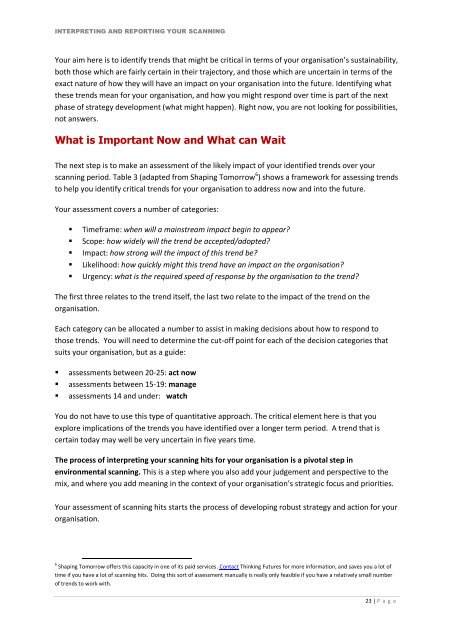Environmental Scanning - Thinking Futures
Environmental Scanning - Thinking Futures
Environmental Scanning - Thinking Futures
Create successful ePaper yourself
Turn your PDF publications into a flip-book with our unique Google optimized e-Paper software.
INTERPRETING AND REPORTING YOUR SCANNING<br />
Your aim here is to identify trends that might be critical in terms of your organisation’s sustainability,<br />
both those which are fairly certain in their trajectory, and those which are uncertain in terms of the<br />
exact nature of how they will have an impact on your organisation into the future. Identifying what<br />
these trends mean for your organisation, and how you might respond over time is part of the next<br />
phase of strategy development (what might happen). Right now, you are not looking for possibilities,<br />
not answers.<br />
What is Important Now and What can Wait<br />
The next step is to make an assessment of the likely impact of your identified trends over your<br />
scanning period. Table 3 (adapted from Shaping Tomorrow 6 ) shows a framework for assessing trends<br />
to help you identify critical trends for your organisation to address now and into the future.<br />
Your assessment covers a number of categories:<br />
• Timeframe: when will a mainstream impact begin to appear?<br />
• Scope: how widely will the trend be accepted/adopted?<br />
• Impact: how strong will the impact of this trend be?<br />
• Likelihood: how quickly might this trend have an impact on the organisation?<br />
• Urgency: what is the required speed of response by the organisation to the trend?<br />
The first three relates to the trend itself, the last two relate to the impact of the trend on the<br />
organisation.<br />
Each category can be allocated a number to assist in making decisions about how to respond to<br />
those trends. You will need to determine the cut-off point for each of the decision categories that<br />
suits your organisation, but as a guide:<br />
• assessments between 20-25: act now<br />
• assessments between 15-19: manage<br />
• assessments 14 and under: watch<br />
You do not have to use this type of quantitative approach. The critical element here is that you<br />
explore implications of the trends you have identified over a longer term period. A trend that is<br />
certain today may well be very uncertain in five years time.<br />
The process of interpreting your scanning hits for your organisation is a pivotal step in<br />
environmental scanning. This is a step where you also add your judgement and perspective to the<br />
mix, and where you add meaning in the context of your organisation’s strategic focus and priorities.<br />
Your assessment of scanning hits starts the process of developing robust strategy and action for your<br />
organisation.<br />
6<br />
Shaping Tomorrow offers this capacity in one of its paid services. Contact <strong>Thinking</strong> <strong>Futures</strong> for more information, and saves you a lot of<br />
time if you have a lot of scanning hits. Doing this sort of assessment manually is really only feasible if you have a relatively small number<br />
of trends to work with.<br />
23 | P a g e



